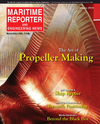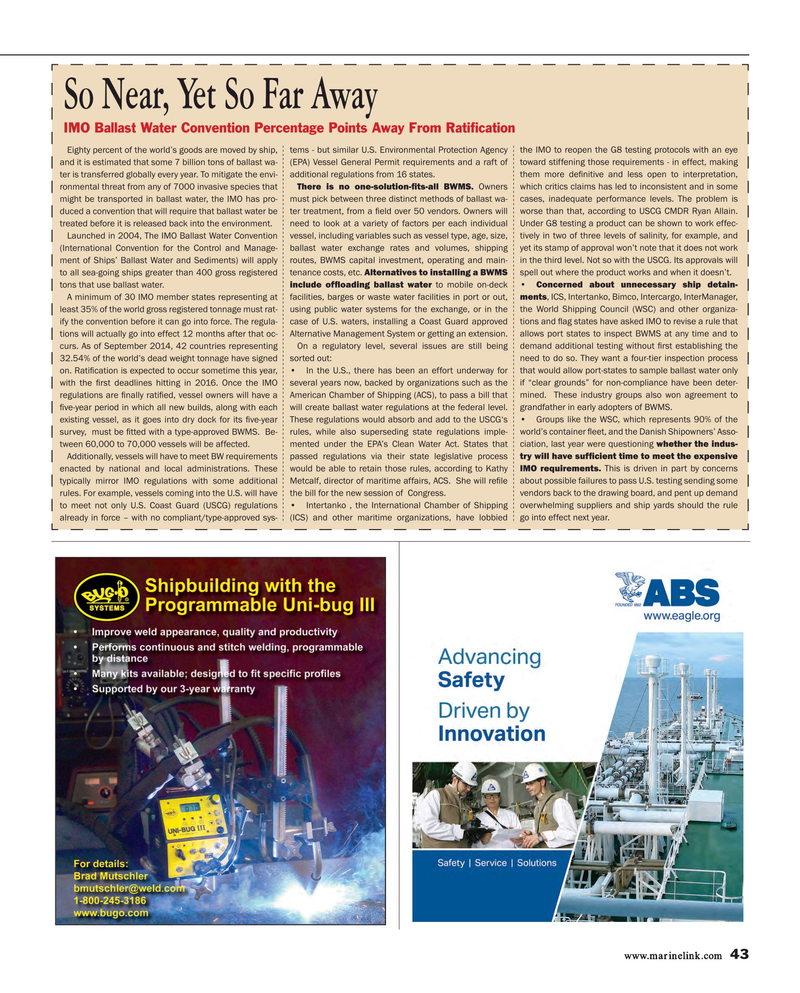
Page 43: of Maritime Reporter Magazine (January 2015)
Ship Repair & Conversion Edition
Read this page in Pdf, Flash or Html5 edition of January 2015 Maritime Reporter Magazine
So Near, Yet So Far Away
IMO Ballast Water Convention Percentage Points Away From Rati? cation
Eighty percent of the world’s goods are moved by ship, tems - but similar U.S. Environmental Protection Agency the IMO to reopen the G8 testing protocols with an eye and it is estimated that some 7 billion tons of ballast wa- (EPA) Vessel General Permit requirements and a raft of toward stiffening those requirements - in effect, making ter is transferred globally every year. To mitigate the envi- additional regulations from 16 states. them more de? nitive and less open to interpretation, ronmental threat from any of 7000 invasive species that There is no one-solution-? ts-all BWMS. Owners which critics claims has led to inconsistent and in some might be transported in ballast water, the IMO has pro- must pick between three distinct methods of ballast wa- cases, inadequate performance levels. The problem is duced a convention that will require that ballast water be ter treatment, from a ? eld over 50 vendors. Owners will worse than that, according to USCG CMDR Ryan Allain. treated before it is released back into the environment. need to look at a variety of factors per each individual Under G8 testing a product can be shown to work effec-
Launched in 2004, The IMO Ballast Water Convention vessel, including variables such as vessel type, age, size, tively in two of three levels of salinity, for example, and (International Convention for the Control and Manage- ballast water exchange rates and volumes, shipping yet its stamp of approval won’t note that it does not work ment of Ships’ Ballast Water and Sediments) will apply routes, BWMS capital investment, operating and main- in the third level. Not so with the USCG. Its approvals will to all sea-going ships greater than 400 gross registered tenance costs, etc. Alternatives to installing a BWMS spell out where the product works and when it doesn’t. tons that use ballast water. include of? oading ballast water to mobile on-deck • Concerned about unnecessary ship detain-
A minimum of 30 IMO member states representing at facilities, barges or waste water facilities in port or out, ments, ICS, Intertanko, Bimco, Intercargo, InterManager, least 35% of the world gross registered tonnage must rat- using public water systems for the exchange, or in the the World Shipping Council (WSC) and other organiza- ify the convention before it can go into force. The regula- case of U.S. waters, installing a Coast Guard approved tions and ? ag states have asked IMO to revise a rule that tions will actually go into effect 12 months after that oc- Alternative Management System or getting an extension. allows port states to inspect BWMS at any time and to curs. As of September 2014, 42 countries representing On a regulatory level, several issues are still being demand additional testing without ? rst establishing the 32.54% of the world’s dead weight tonnage have signed sorted out: need to do so. They want a four-tier inspection process on. Rati? cation is expected to occur sometime this year, • In the U.S., there has been an effort underway for that would allow port-states to sample ballast water only with the ? rst deadlines hitting in 2016. Once the IMO several years now, backed by organizations such as the if “clear grounds” for non-compliance have been deter- regulations are ? nally rati? ed, vessel owners will have a American Chamber of Shipping (ACS), to pass a bill that mined. These industry groups also won agreement to ? ve-year period in which all new builds, along with each will create ballast water regulations at the federal level. grandfather in early adopters of BWMS. existing vessel, as it goes into dry dock for its ? ve-year These regulations would absorb and add to the USCG‘s • Groups like the WSC, which represents 90% of the survey, must be ? tted with a type-approved BWMS. Be- rules, while also superseding state regulations imple- world’s container ? eet, and the Danish Shipowners’ Asso- tween 60,000 to 70,000 vessels will be affected. mented under the EPA’s Clean Water Act. States that ciation, last year were questioning whether the indus-
Additionally, vessels will have to meet BW requirements passed regulations via their state legislative process try will have suf? cient time to meet the expensive enacted by national and local administrations. These would be able to retain those rules, according to Kathy IMO requirements. This is driven in part by concerns typically mirror IMO regulations with some additional Metcalf, director of maritime affairs, ACS. She will re? le about possible failures to pass U.S. testing sending some rules. For example, vessels coming into the U.S. will have the bill for the new session of Congress. vendors back to the drawing board, and pent up demand to meet not only U.S. Coast Guard (USCG) regulations • Intertanko , the International Chamber of Shipping overwhelming suppliers and ship yards should the rule already in force – with no compliant/type-approved sys- (ICS) and other maritime organizations, have lobbied go into effect next year. www.marinelink.com 43
MR #1 (42-49).indd 43 MR #1 (42-49).indd 43 1/7/2015 10:53:11 AM1/7/2015 10:53:11 AM

 42
42

 44
44
